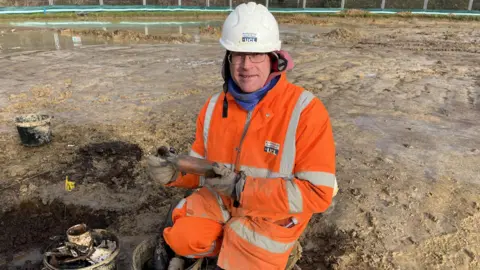“By the end, I was just wondering how I would prefer to die.”
Spending 35 hours trapped in a pitch-black air pocket in the upturned hull of a boat has taken its toll on Lucianna Galetta, her voice cracking as she recounts her ordeal.
A video she managed to film briefly using the light on her phone, now shared with the BBC, shows the space where she thought her life might end – and how surging sea water and floating debris prevented her escape.
Lucianna was one of the last of 35 survivors to be rescued from the wreck of the Sea Story, an Egyptian dive vessel that sank in the Red Sea on 25 November last year. Up to 11 people died or are still missing, including two Britons, Jenny Cawson and Tarig Sinada from Devon.
At the time, Egyptian authorities attributed the disaster to a huge wave of up to 4m (13ft), but the BBC has spoken to 11 survivors of the Sea Story who have cast doubt on the claim. That has been supported by a leading oceanographer, who told us weather data from the time suggests a wave could not have been responsible, and that a combination of crew error and failings in the boat were the likely cause.
As well as describing the terror of being trapped in a rapidly sinking boat, the survivors accuse the company which ran it, Dive Pro Liveaboard, of several safety failings. They also say the Egyptian authorities were slow to react, something which may have cost lives. We have put questions to Dive Pro Liveaboard – based in Hurghada – and the Egyptian government, but not received any reply.
This, for the first time, is the inside story of how the Sea Story sank, as told by those who made it out alive.
The luxury dive boat set off from Port Ghaleb on Egypt’s Red Sea Coast on 24 November. On board were 31 international guests – mostly experienced divers – and three dive guides, along with 12 Egyptian crew. They were on a six-day trip, with their first destination being Sataya Reef, a popular diving spot.
Like many of those on board, Lucianna’s first impressions of the Sea Story were positive. “It looked like a really nice boat, very big, very clean,” she says, speaking from her home in Belgium.
The company had transferred over Lucianna and others at the last minute from another boat, which had hundreds of good online reviews. Several guests were told they were getting an “upgrade” but some were frustrated because it was not going to the destination they had booked.
Conditions that night were quite rough, although the survivors we spoke to, including experienced sailors, say the boat seemed more unstable than they would have expected.
At one point, a few hours before the capsizing, a small inflatable boat slipped off the back of the Sea Story. A passenger filmed as the crew battled to bring it back on board – the oceanographer the BBC spoke to says the video shows conditions which were not unusual and consistent with 1.5m (5ft) waves.
“Looking out at the waves, the weather wasn’t terrible,” says Sarah Martin, an NHS doctor from Lancaster who was on the trip. But, she says, “furniture was sliding around the deck – we asked the crew if it was normal and they just shrugged, so we didn’t realise the danger we were in”.
“I didn’t sleep that night because the boat was rocking so much,” says Hissora Gonzalez, a diver from Spain, whose cabin was on the lower deck.
She describes how the boat rolled sharply several times until, just before 03:00, it flipped onto its side with a loud bang, followed by silence as the engines died – and total darkness.
Shouting could soon be heard coming from other cabins, as people were thrown from their beds. Possessions were scattered around, blocking exits and making escape difficult. One survivor – who had been sleeping outside on deck – described being trapped under heavy furniture which had shifted as the boat rolled.











No comments yet. Be the first to comment!